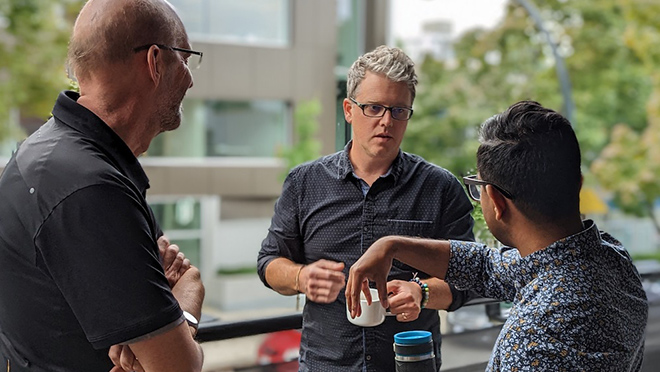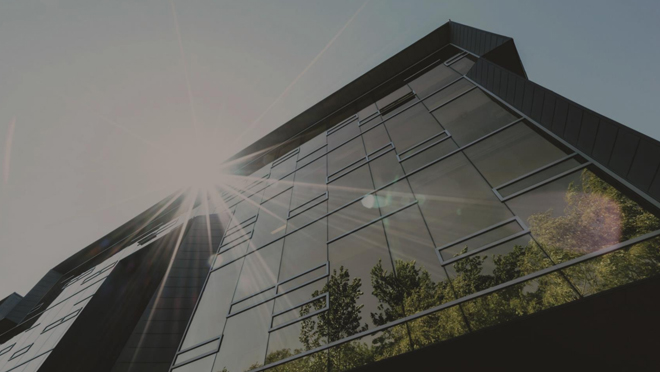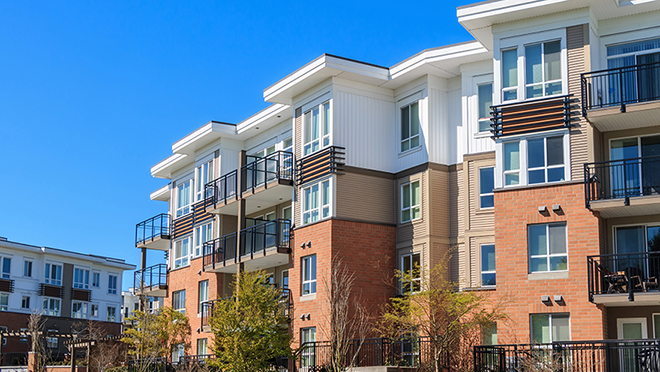December 2024

Partner Q & A: Chris Higgins, City of Vancouver's senior green building planner
Chris Higgins, who has worked for the City of Vancouver (the City) since 2014 as a leader in green building policy, is B.C.’s first Energy Connections and Infrastructure Manager. It's a new pilot role based within local governments – in this case the City of Vancouver – and co-funded 50% by BC Hydro. Higgins' focus is to serve as a liaison between the City and BC Hydro’s distribution design and customer connections group, with the goal to improve the electrical connections processes for new construction. This role will be critical as the City narrowly voted on November 28 to maintain the requirement for electrical heating and hot water for all new construction.
We sat down with Higgins to talk about electrical connections, building codes, and what he has learned working alongside BC Hydro staff.
Plugged In: Can you start by summarizing your key role with the City of Vancouver?
Chris Higgins: My role focuses on simplifying the process for builders and homeowners to obtain electrical connections for new buildings and upgrades. My work with BC Hydro and the City is to find solutions, and to update standards and codes, all aimed at making it easier to create energy-efficient, environmentally friendly homes.
PI: Electrification is seen as a key ingredient in climate action. Are you happy with the progress you’re making in Vancouver?
CH: One in four new vehicles in Vancouver are electric. Most new homes have a heat pump that provides heating and cooling, so Vancouver is making great progress towards a cleaner future. Across North America, 2022 was the first year that heat pumps outsold furnaces.
PI: BC Hydro recently released an online guide, the small-scale, multi-unit housing guide for local governments. And you're finalizing a City of Vancouver guide to help builders and developers with electrical service sizes. What’s the status of that initiative, and what can we expect?
CH: It's going to be published around mid-December, and we're likely to start talking about it with industry in January. We've worked with builders, developers, and architects – along with BC Hydro and the City of Vancouver as stakeholders – to develop a guide that achieves two things: it sets builders up for success with a service connection of 400 amps or large, and it provides builders with power efficient design strategies and knowledge to manage their service size requests.
PI: Can you provide an example of what will be in that guide?
CH: Let's say I’m building a triplex, a three-unit building and installing electric vehicle charging chargers for each of the dwellings. The electrical service for the dwellings could easily be 100 amps, or could be a little less, electric vehicle chargers alone could each require 60 amps. So that's quite a bit of capacity needed. But there's hardware and software that's available off the shelf that can allow your electrical vehicle charger to intelligently maximize the amount of electricity that's available from your 100A service. You can leave with a full charge every morning and not pay more than needed. This guide will provide a tool for builders and developers so they can right-size the service.
PI: You've said that developers and builders have become familiar with BC Hydro's express connections service, but many don't realize the added complexity – and time requirement – BC Hydro faces with larger service connections.
CH: It's kind of like if I order pizza for dinner, I pick up a phone and provide information on where my house is, and which toppings I want. That's the express connection. It's a great service, streamlined and easy, and it works really well for single-family and duplex homes with a 200A or smaller connection. But now that the City is allowing greater density – three-, four-, five- and six-plexes – larger connections are needed through BC Hydro's design connections. And that's more like making your own pizza. You can do it, so long as you plan for it, get the dough and the ingredients in advance. I'm working with builders, designers, and developers to plan and complete the design work with BC Hydro whilst the City reviews the development and building permits.
PI: You're working directly with BC Hydro distribution connections staff in BC Hydro's office in Burnaby. How did that initiative start?
CH: In 2022, while I was still working soley from the City of Vancouver office, I visited the site of a triplex, built under Vancouver's duplex zoning but the owners were adding an extra unit. The project was at lockup – windows were in, the roof was on, and they were finishing the interior. The builder called us because they were concerned that BC Hydro was taking too long to get their electrical connection done. It turned out that they hadn’t started the process with BC Hydro until very late – a couple weeks before lockup stage. The builder only had experience with the express connection process before, but this project required a 400-amp service and a design connection that included a new transformer on the property. It's like the applicants had only ordered the pizza, and then all of a sudden it's 5 o'clock and they're like, "OK, let's make pizza from scratch."
PI: And it turns out there were a whole bunch of developers and builders who didn’t know how to make their own pizza?
CH: I saw that at maybe 50 sites I visited over the next year. Electrical teams were saying they were brought on late and had started the design connection process but didn’t have much time. I asked BC Hydro if I could work directly with their distribution design team, in their office, because I saw the opportunity to improve the process.
PI: How has that experiment – which has been extended into a formal co-funded energy connections and infrastructure manager position – worked out so far?
CH: The big shift at BC Hydro and the City of Vancouver has been the process for these applications. It used to be consecutive – make an application to the City, and then later to BC Hydro. Now the City and BC Hydro applications start at the same time. The City is also allowing BC Hydro to make all electrical connection decisions for developments of fewer than eight units, which accelerates the process.
PI: With the move to densify in Vancouver, how many new projects have required at least 400-amp service?
CH: Out of our first 150 multiplex projects – 74% required 400-amp service, 21% are 600-amp or higher, and 5% are 200 amp. It kind of highlights the change before us.
PI: BC Housing and BC Hydro have co-funded a number of helpful guides for industry that support market transformation to more energy-efficient low-carbon buildings. What else would you recommend to local governments in terms of improving processes with BC Hydro?
CH: Have a single point of contact, a single person to call if there’s a problem or challenge that BC Hydro needs to resolve in a timely manner. That person doesn't actually have to come up with a solution, but they can act as a bit of a traffic controller to help resolve issues earlier.
PI: Any plans to take some of the ideas you’ve developed with BC Hydro on the road?
CH: Next year, the Community Energy Manager Network is planning to do a peer support piece with the distribution design team. I'll co-deliver presentations to other municipalities on the changes that we've made to our processes and what changes they could consider. I’ll offer documents and my support to other municipalities.
PI: What would you like to see happen next around green building in B.C.?
CH: The steps that we've made in energy efficiency and BC have been great, and that work should continue to advance to lower monthly energy costs for citizens in new homes. More work on the adoption of the Zero Carbon Step Code will help deliver greater comfort in new homes while reducing pollution. But municipalities across B.C. are taking steps in the right direction in planning – that’s what municipalities are good at. I'd just like to see a little more coordination with BC Hydro, as it allows the shift to electrification to happen in an orderly and planned fashion.

Community Energy Managers join forces in our ideation workshops
Each year a group of local government community energy managers – roles that are co-funded by BC Hydro – gets together for a workshop. Over two days, they come up with ideas that spawn up to five projects, each advancing with BC Hydro funding.
Call it Dragons' Den lite, where the emphasis is more on collaboration than competition, and where ideas often join hands.
"The ideas start with our partners defining problems," says Josh Power, program manager at BC Hydro, part of our market transformation team which hosts the event. "By the end of the two days, they're turning those problems into potential solutions and into fully-scoped projects that they can go off and test."
Over the years, projects produced have included:
- An "It's getting hot in here" technical report aimed at helping builders design for future climate conditions, with emphasis on ensuring safety and cooling for our increasingly hot summers.
- A "Put a Label on it" report delving into the disclosure of BC Energy Step Code, EnerGuide, and other home energy standards and ratings.
- An "Are all-electric homes safe during a power outage" info sheet for homeowners.
The ideation workshops are by invitation only. There are a lot of repeat participants, and invitations are sent not just to current energy managers, but to workshop alumni, and members of Indigenous organizations.
"You're not trying to come with a baked solution that you're trying to sell people on," says Power. "You're coming with an open mind to say, 'this is an area where we're having trouble or something that needs attention, and how might we address it?'"
An ideation veteran looks back on nine years of workshops
Ralph Wells is the University of B.C.'s community climate and energy manager, and he’s an ideation workshop veteran who's attended all nine workshops to date.
One of his favourite projects greenlit out of the 2024 workshop is a project that will explore the impact of EV charging requirements for new multi-unit residential buildings.
The City of Richmond led this policy in 2018 to ensure that new buildings would be wired to support EV charging for residents.
"Many local governments implemented the same requirements across B.C.," says Wells. "One of my colleagues at this year’s ideation workshop pitched that we need to look at the outcomes of this policy. How easy is it for residents and stratas to charge EVs now in these buildings? Are any changes needed to this requirement? I’m looking forward to what this study tells us."

B2E Commercial Building Electrification Guide arrives
On November 14, dozens of B.C. builders, building owners, and consultants connected online for the release of B2E's Commercial Building Electrification Guide.
The goal of the guide is to enable consultants to design and implement successful building electrification projects and build the sector's capacity to reach B.C.'s emissions reduction targets.
"While every building is unique, many of the solutions and strategies to approach retrofits are replicable," said B2E's Mariko Michasiw. "Given that the majority of commercial building stock already exists, and that the mechanical systems will last 15 years or more, and envelopes last even longer, it's imperative that we avoid locking ourselves into higher GHG emissions for another 15 plus years."
The guide is a whopper, running at more than 200 pages but it's easy to navigate its contents, like planning, implementation, and design. The guide's consultants SES and First Light Energy Solutions liken it to a "Choose your own adventure" experience.
The guide has a built-in commenting tool that will allow for collaborative updates and revisions. It's designed to be future-proofed while still providing data-driven specifics around current technologies.
Funding for the guide’s development was provided by BC Hydro, City of Vancouver, Metro Vancouver, and the Building to Electrification Coalition (B2E).

As codes evolve, BC Housing guides help builders stay in step
BC Housing is the province's largest builder of social housing, constructing more than 24,000 social housing units across B.C. since 2018.
Many of these buildings are constructed to higher standards, thanks to BC Housing's energy performance requirements for projects they fund and finance. These requirements reference the step codes and surpass the basic BC Building Code.
BC Housing's Wilma Leung is passionate about sharing lessons from BC Housing's projects with the rest of the building community. As senior manager of technical research and education, she's partnered with BC Hydro and other organizations to publish a series of best practice guides for improving energy and carbon performance for builders, developers, and homeowners.
Recent guides include:
- Design Guide for Domestic Hot Water Heat Pumps in New MURBs
- Maintenance Matters No. 23 - Electrical Planning for Multi-Unit Residential Buildings
- Detailing Guide for Heat Pump Penetrations in Existing Buildings
- Building Innovation: Does High Performance Construction Cost More?
- Realizing Resilient Buildings in B.C. – A Toolkit for Local Governments
"When the Energy Step Code was introduced in 2017 it set a 15-year timeline that gives people a chance to adapt over time," says Leung. "We're working on more guides that will support the implementation of the step codes, as well as general best practices that support builders to meet what B.C. needs in the future."
BC Hydro's Elyse Henderson works within our market transformation team as a policy advisor collaborating with government and industry to advance codes, policy, and standards. She says BC Housing has been a trusted partner because they share common goals with BC Hydro around efficiency and decarbonization.
"Ever since they set up the Homeowner Protection Office as a response to the leaky condo crisis, their mandate has been to make sure that buildings are built in a quality way that serves the residents of British Columbia. This makes them a great partner for us," says Henderson.
Learn more about BC Housing's resources and learning tools in their online Research Centre.